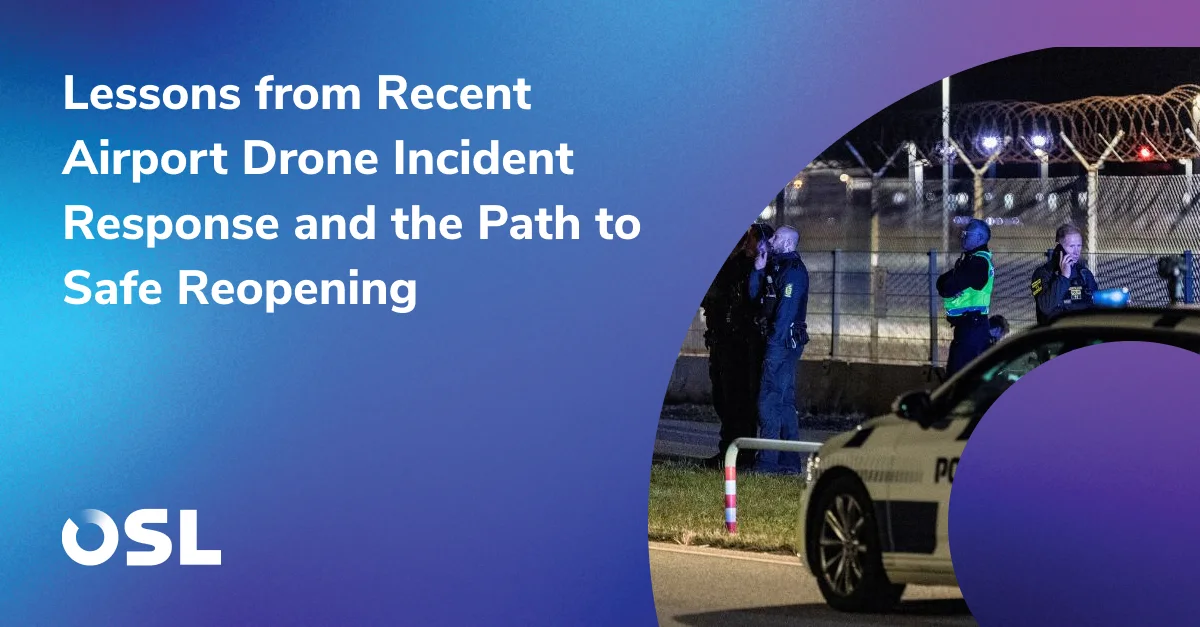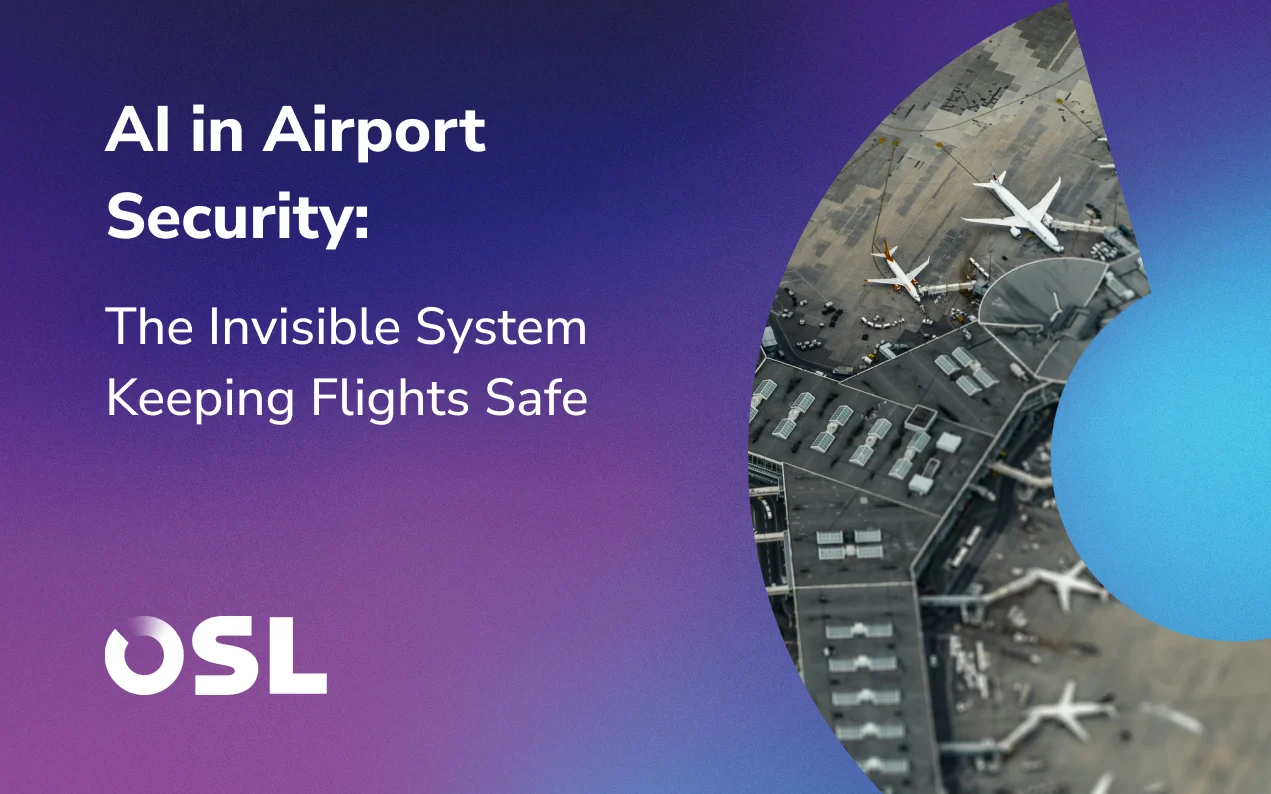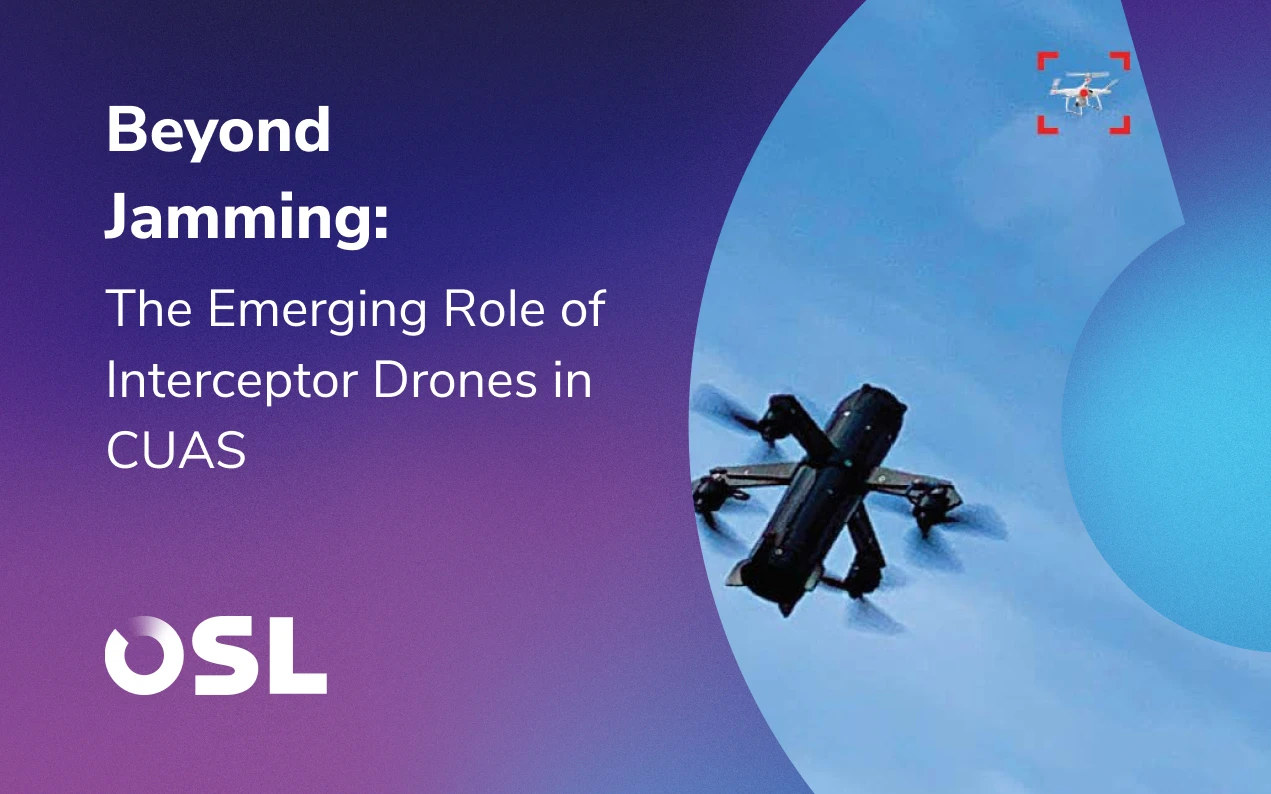CUAS Readiness at Airports: Lessons from Recent Airport Drone Incident Response and the Path to Safe Reopening


Drone incidents at airports and other critical sites are no longer rare. The sharp rise in reports across Europe and beyond marks a turning point that many in the aviation and CUAS sectors have long anticipated. These events are not isolated disruptions or symbolic acts, they represent an operational and procedural challenge that airport authorities must now be structurally prepared to handle.
The threat itself is changing. While some drones are now operated autonomously, with pre-programmed flight paths or spoofed navigation signals, most are still manually controlled. Both modes introduce distinct challenges: autonomous flights can be harder to detect and verify, while human-controlled flights often adapt rapidly and exploit procedural gaps.
When an alert occurs, the first question for airport operators is not always how to respond, but whether the threat is real. False positives do occur, and without a trusted verification process, teams risk either overreacting or delaying action at the worst possible time. Yet the bigger issue lies beyond detection. There is still no shared benchmark for CUAS readiness at airports, no common definition of what “good” looks like, and no unified process for how to verify clear airspace after a drone incursion.
Responsibility remains fragmented across airports, police, air navigation service providers (ANSPs), and regulators. Unless those interfaces are clearly defined and rehearsed, confusion will resurface at the very moment clarity is most needed.
Drawing on lessons from live deployments in Europe’s busiest civilian airspace, this blog examines what recent incidents reveal about readiness and how airports can transition from reactive closure to structured, data-driven reopening. It also outlines what each stakeholder must do to make that transition possible.
1. The Standard That Doesn’t Exist
Despite rising awareness, there is still no binding or universally recognised standard for airport CUAS capability. Most aerodromes are under no obligation to meet measurable targets for detection, tracking, or airspace verification.
Instead, a mix of voluntary programmes has emerged. Some airports have invested in layered CUAS solutions combining radar, RF, and optical sensors within coordinated command-and-control environments. Others, citing limited budget or absent regulation, continue to defer.
The European Union Aviation Safety Agency (EASA) has issued useful guidance for managing drone incidents, including recommendations to minimise closure times and improve coordination. Yet these remain non-binding, leaving implementation inconsistent across Europe. Without defined CUAS readiness metrics or a clear regulatory baseline, airports interpret “sufficient preparation” in different ways.
The result is a system that lacks clear incentives for proactive investment. Airports that act early gain no official recognition, while those that delay face little consequence until disruption occurs. As drone activity around airports continues to grow, that imbalance is becoming untenable.
Work in this area is already progressing. The EUROCAE Working Group WG-115, for which OSL’s Mark Lupton serves as Secretary, is developing international standards for CUAS integration in civil aviation. In parallel, contributions to the ISO standards body are helping to define consistent performance and testing criteria. These efforts represent an important step toward the harmonised readiness framework airports need.
Establishing a standardised, auditable CUAS readiness framework is now a safety imperative, not an administrative one.
2. Metrics That Matter
Even without a formal standard, airports can measure their readiness. Establishing key CUAS readiness metrics enables operators to track performance, refine procedures, and demonstrate competence to regulators and airlines alike.
Four indicators are especially critical:
- Time-to-detect: How quickly a threat is identified once it enters the protected zone.
- Time-to-track: How long it takes to establish a stable, correlated track.
- Time-to-classify: The interval before confirming that the object is a drone, not a false return.
- Time-to-verify-clear: How soon operators can confirm that the airspace is safe to reopen.
These measures turn incident response from guesswork into governance. They provide a shared language between airport operators, ANSPs, and law enforcement. This ensures that airport reopening decisions are based on evidence rather than instinct.
As highlighted in OSL’s Lessons from Airports report, it is often the absence of clear verification data, not the continued presence of drones, that prolongs closures. Defining and rehearsing these metrics should therefore be the cornerstone of any airport drone-incident response strategy.
3. Responsibility Is Fragmented, but That’s Changing
The question of who leads CUAS coordination is becoming one of the most urgent operational issues facing airports today. Regulators govern policy, ANSPs manage the airspace, police hold enforcement powers, and airport operators maintain infrastructure, yet no single body owns the full response chain.
This diffusion of responsibility creates hesitation. Operators wait for direction, ANSPs await confirmation, and police face legal uncertainty about when they can act. The result can be procedural delay, amplifying the operational impact of an incident.
Recent events, however, suggest this is starting to change. In several jurisdictions, national defence or security agencies have temporarily stepped in to provide CUAS coverage or response support. This reflects growing recognition that drone incursions at airports are not simply operational nuisances but national-security risks.
If the threat is national, funding and accountability may need to follow suit. Shared frameworks between civil and defence bodies could define roles, responsibilities, detection, verification, and decision-making, ensuring smaller airports are not left behind. Clearer responsibility means faster coordination and safer skies.
4. Detection Is Not Enough, Verification Is the Goal
Modern CUAS command-and-control systems can detect drones with remarkable precision, but detection alone does not reopen airspace. Verification, proving that the airspace is clear, is the real goal.
After an alert, airports often face a surge of secondary sightings from staff or passengers, many of which are unconfirmed. Without verified sensor data, decision-makers cannot disprove these reports with confidence. That uncertainty often prolongs operational pauses beyond what may be required for safety.
Fused, multi-sensor data, combining radar, RF, and optical tracks, enables operators to confirm safe airspace quickly. When detection is paired with visual evidence and timestamped records, it becomes possible to separate false alarms from real threats.
Modern CUAS solutions must evolve into detection-to-decision support systems, where fusion, visual confirmation, and timestamped data turn detection into verifiable action. CUAS effectiveness depends not only on how quickly a drone is detected, but on how safely it enables flight operations to resume. Verification, not visibility, defines readiness.
5. Locate the Controller, End the Threat
In many cases, the most effective form of response is to identify and apprehend the drone operator. RF geolocation tools can help trace the controller’s position in real time, allowing coordinated intervention by police. In some cases, analysis of the drone’s launch point, use of launch-point algorithms, or pattern-of-life analysis can also reveal where a drone is being operated from.
Recent reports suggest that certain incidents may even involve drones launched and controlled from vessels in coastal waters, highlighting the growing complexity of threat origin and jurisdiction.
This is where multi-agency coordination becomes critical. If law enforcement and airport operations teams share data and authority, a single arrest can end an incident and deter future incursions. Yet even the most precise intelligence depends on prior authorisation and training to be actionable.
Establishing clear command pathways and practising them under live conditions ensures that actionable data leads to real outcomes. The faster a controller can be located, the sooner the incident, and its operational impact, can end.
6. Operational Response Measures and Effector Systems
Before escalation, airports can adopt a range of operational responses designed to minimise disruption and maintain safety. These may include identifying and locating the pilot, altering runway configurations, temporarily pausing ground movements, or rerouting arriving traffic. Such measures are familiar from other disruption scenarios, including cyber incidents and wildlife hazards, and remain the first line of defence when legal authorisation for effectors is limited.
When escalation becomes unavoidable, effector systems may be used under authorised conditions. These include options such as protocol jamming, GNSS denial, cyber takeover, interceptor drones, and high-power microwave systems. Each has different operational and legal implications.
Within civilian airspace, these measures must be deployed with extreme caution. Few European states have harmonised authorisation frameworks that allow their use near populated or critical infrastructure. This creates a difficult choice: act without full legal cover, or delay until clearance is obtained.
Establishing clear legal and procedural pathways for controlled mitigation is vital. The US Federal Aviation Administration (FAA) offers a reference point, maintaining an integrated approach to both detection and limited-authorisation mitigation. Europe risks lagging behind if it cannot provide similar clarity for civil CUAS deployments.
7. Command and Training Are Non-Negotiable
Even the most advanced CUAS systems depend on well-trained human operators and clear command structures. A decision-support platform may fuse multi-sensor intelligence in real time, but it cannot replace informed judgment.
Airports should conduct regular tabletop and live exercises that simulate end-to-end drone incursions. These exercises should test not only the hardware but also the decision process: Who closes the airspace? Who verifies it is clear? Who decides when to reopen?
Empowering operators to act confidently under pressure is the hallmark of true readiness. Without structured training and delegated authority, even the most capable CUAS deployment can become paralysed by uncertainty.
8. Airspace Reopening Is the Real Measure of Readiness
Temporary airspace closure may feel decisive, but airspace reopening defines credibility. Airlines, passengers, and regulators judge success by how an incident was handled and how quickly operations resumed. In many cases, airspace restrictions last only minutes, full airport closures are rare.
However, once an incident becomes public, well-intentioned staff or witnesses may report additional drone sightings that are difficult to verify. This can prolong delays unless operators have a reliable CUAS system to confirm when the airspace is genuinely clear.
Safe airspace reopening depends on three conditions:
- Verified data confirming the airspace is clear.
- Agreed protocols between airports, ANSPs, and police.
- Confidence that all agencies share the same operational picture.
When those conditions are met, reopening becomes a controlled, evidence-based decision. When they are not, it becomes a gamble.
9. Policy Is Moving, But Still Too Slowly
Some policy groundwork exists, but not enough to meet the scale of the challenge. EASA continues to issue valuable recommendations, and national regulators in countries like Germany, Italy, and the Netherlands are developing CUAS incident protocols. Yet these efforts remain fragmented and voluntary, lacking the force and uniformity of aviation safety regulations.
Funding and readiness expectations still vary by airport size, rather than by airspace risk. Smaller regional airports face the same exposure to drone incursions but lack the resources to invest in multi-sensor systems or trained response staff. A fair, tiered funding model linking CUAS obligations to airport classification would help address this imbalance.
Equally important is the need for formal authorisation frameworks governing when and how mitigation can be activated. In many countries, uncertainty over legal responsibility delays responses that could otherwise be decisive. Harmonised approval processes, backed by training and record-keeping, would ensure that every airspace-closure protocol is transparent, repeatable, and defensible.
Europe also needs a centralised CUAS knowledge base to capture incident data, share operational lessons, and inform future standards. A pan-European repository, similar to the FAA’s database, would turn individual experiences into collective improvement and create the evidence base policymakers currently lack. Until such structures exist, even the most advanced CUAS deployments will remain constrained by fragmented regulation and slow authorisation.
Conclusion
The past year has shown that airport drone incidents are an operational inevitability. The difference between disruption and resilience now depends on readiness.
CUAS readiness is a layered system that combines technology, coordination, and trust. Airports that have defined responsibilities, measured their performance, and rehearsed their response will reopen faster and with greater confidence. Those still developing their processes will continue to face uncertainty whenever an alert occurs.
The next phase for the aviation industry must focus on turning lessons learned into standards adopted. That means:
- Establishing measurable CUAS readiness metrics and auditing them routinely.
- Funding scalable, layered detection-to-decision solutions based on site risk.
- Creating unified national protocols for closure, verification, and reopening.
- Training operators and empowering decision-makers to act under pressure.
Drones will continue to evolve, but so can our defences. By treating reopening as the mission outcome, rather than a recovery stage, airports can transition from reactive closure to proactive resilience. The objective is to reopen with evidence, coordination, and trust.
FAQ: Coordinating CUAS Response and Safe Reopening at Airports
1. What defines an effective drone incursion airport response?
Airports respond effectively to drone incursions by detecting threats early, coordinating with law enforcement and air traffic control. They can even verify the airspace before reopening. A structured drone incursion airport response ensures fast, decisive action.
2. How does CUAS coordination between airports, police, and ANSPs improve safety?
Airports, police, and ANSPs improve safety by sharing real-time information and acting in unison. Strong CUAS coordination between airports, police, and ANSPs reduces delays, enforces legal procedures, and accelerates safe incident resolution.
3. How can airports safely reopen after a commercial drone alert?
Airports can safely reopen after a drone alert by using verified, fused sensors data, following agreed protocols and executing rehearsed procedures. Clear rules on how airports can safely reopen after a drone alert turn decisions into controlled, evidence-driven actions.
4. What is meant by detection-to-decision support drone defence?
CUAS systems provide detection-to-decision support for drone defence by combining radar systems, RF, and optical inputs to create actionable intelligence. Operators then confirm threats, clear the airspace, and resume operations confidently.
5. Who holds responsibility for drone threats posed at airports?
Airport operators, ANSPs, and police share responsibility for drone threats. Clear rules, response plans, and joint training help teams act quickly, making it clear who is responsible for drone threats at airports.
Editor's Pick
Secure your airspace with adaptive drone defence solutions
Ensure operational safety with multi-layered solutions designed to counter unauthorised drones and protect complex environments.




